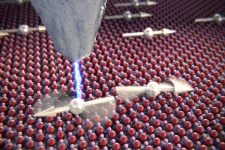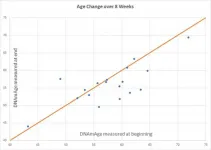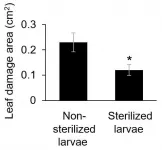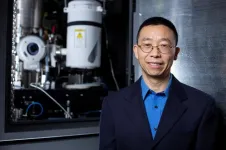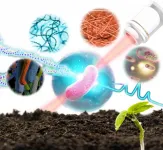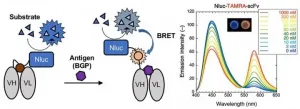(Press-News.org) Quantum systems are considered extremely fragile. Even the smallest interactions with the environment can result in the loss of sensitive quantum effects. In the renowned journal Science, however, researchers from TU Delft, RWTH Aachen University and Forschungszentrum Jülich now present an experiment in which a quantum system consisting of two coupled atoms behaves surprisingly stable under electron bombardment. The experiment provide an indication that special quantum states might be realised in a quantum computer more easily than previously thought.
The so-called decoherence is one of the greatest enemies of the quantum physicist. Experts understand by this the decay of quantum states. This inevitably occurs when the system interacts with its environment. In the macroscopic world, this exchange is unavoidable, which is why quantum effects rarely occur in daily life. The quantum systems used in research, such as individual atoms, electrons or photons, are better shielded, but are fundamentally similarly sensitive.
"Systems subject to quantum physics, unlike classical objects, are not sharply defined in all their properties. Instead, they can occupy several states at once. This is called superposition," Markus Ternes explains. "A famous example is Schrödinger's thought experiment with the cat, which is temporarily dead and alive at the same time. However, the superposition breaks down as soon as the system is disturbed or measured. What is left then is only a single state, which is the measured value," says the quantum physicist from Forschungszentrum Jülich and RWTH Aachen University.
Given this context, the experiment that researchers at TU Delft have now carried out seems all the more astonishing. Using a new method, they succeeded for the first time in real-time observing how two coupled atoms freely exchange quantum information, switching back and forth between different states in a flip-flop interaction.
"Each atom carries a small magnetic moment called spin. These spins influence each other, like compass needles do when you bring them close. If you give one of them a push, they will start moving together in a very specific way," explains Sander Otte, head of the Delft team that performed the experiment.
On a large scale, this kind of information exchange between atoms can lead to fascinating phenomena. Various forms of quantum technologies are based on these. A classical example is superconductivity: the effect where some materials lose all electrical resistivity below a critical temperature.
Unconventional approach
To observe this interaction between atoms, Otte and his team chose a rather direct way: Using a scanning tunnelling microscope, they placed two titanium atoms next to each other at a distance of just over one nanometre - one millionth of a millimetre. At that distance, the atoms are just able to feel each other's spin. If you would now twist one of the two spins, the conversation will start by itself.
Usually, this twist is performed by sending very precise radio signals to the atoms. This so-called spin resonance technique - which is quite reminiscent of the working principle of an MRI scanner found in hospitals - is used successfully in research on quantum bits. Among other things, quantum bits in certain types of quantum computers are programmed in such a way. However, the method has a disadvantage. "It is simply too slow," says PhD student Lukas Veldman, lead author on the Science publication. "You have barely started twisting the one spin before the other starts to rotate along. This way you can never investigate what happens upon placing the two spins in opposite directions."
So the researchers tried something unorthodox: they rapidly inverted the spin of one of the two atoms with a sudden burst of electric current. To their surprise, this drastic approach resulted in a beautiful quantum interaction, exactly by the book. During the pulse, electrons collide with the atom, causing its spin to rotate. Otte: "But we always assumed that during this process, the delicate quantum information - the so-called coherence - was lost. After all, the electrons that you send are incoherent: the history of each electron prior to the collision is slightly different and this chaos is transferred to the atom's spin, destroying any coherence."
The fact that this now seems not to be true was cause for some debate. Apparently, each random electron, regardless of its past, can initiate a superposition: a specific combination of elementary quantum states which is fully known and which forms the basis for almost any form of quantum technology. The aspect that these electrons are still connected to their environment via their history is obviously irrelevant. What is at stake here, then, is the violation of a principle of quantum physics, according to which every measurement irretrievably destroys the superposition of quantum states.
"The crux is that it depends on the perspective," argues Markus Ternes, co-author of the Science paper. "The electron inverts the spin of one atom causing it to point, say, to the left. You could view this as a measurement, erasing all quantum memory. But from the point of view of the combined system comprising both atoms, the resulting situation is not so mundane at all. For the two atoms together, the new state constitutes a perfect superposition, enabling the exchange of information between them. Crucially for this to happen is that both spins become entangled: a particular quantum state in which they share more information about each other than classically possible."
The discovery could have far-reaching consequences for the development of quantum computers, whose function is based on the entanglement and superposition of quantum states. If one follows the findings, one could get away with being slightly less careful when initializing quantum states than previously thought. For Otte and his team at TU Delft, however, the result is above all the starting point of further exciting experiments. Veldman: "Here we used two atoms, but what happens if you use three? Or ten, or a thousand? Nobody can predict that, because the computing power [for simulating such] numbers is not sufficient."
INFORMATION:
A groundbreaking clinical trial shows we can reduce biological age (as measured by the Horvath 2013 DNAmAge clock) by more than three years in only eight weeks with diet and lifestyle through balancing DNA methylation. A first-of-its-kind, peer-reviewed study provides scientific evidence that lifestyle and diet changes can deliver immediate and rapid reduction of our biological age. Since aging is the primary driver of chronic disease, this reduction has the power to help us live better, longer. The study, released on April 12, utilized a randomized controlled clinical trial conducted among 43 healthy adult males between the ages of 50-72. The 8-week treatment program included diet, sleep, exercise and relaxation ...
The bacterium, which they named Candidatus Phytoplasma dypsidis was found to cause a fatal wilt disease. This new discovery was reported in the International Journal of Systematic and Evolutionary Microbiology.
In 2016, several ornamental palms within a conservatory in the Cairns Botanic Gardens, Queensland, died mysteriously. A sample was taken from one of the diseased plants and investigated by Dr Richard Davis and colleagues from the Australian Government Department of Agriculture, Water and the Environment, and state and local government. They compared the characteristics and genome of the bacterium identified as the cause of the disease and found the ...
Study Exploring Optimization of Duplex Velocity Criteria for Diagnosis of Internal Carotid Artery (ICA) Stenosis Published Online
Online first in Vascular Medicine, researchers from the Intersocietal Accreditation Commission (IAC) Vascular Testing division report findings of their multi-centered study of duplex ultrasound for diagnosis of internal carotid artery (ICA) stenosis. 1
The study was developed in response to wide variability in the diagnostic criteria used to classify severity of ICA stenosis across vascular laboratories nationwide and following a survey of members of IAC-accredited ...
Aging published "Potential reversal of epigenetic age using a diet and lifestyle intervention: a pilot randomized clinical trial" which reported on a randomized controlled clinical trial conducted among 43 healthy adult males between the ages of 50-72. The 8-week treatment program included diet, sleep, exercise and relaxation guidance, and supplemental probiotics and phytonutrients. Genome-wide DNA methylation analysis was conducted on saliva samples using the Illumina Methylation Epic Array and DNAmAge was calculated using the online Horvath DNAmAge clock (also published in Aging). The diet and lifestyle treatment was associated with a 3.23 years decrease in DNAmAge compared with controls. DNAmAge of those in the treatment group decreased by an average 1.96 ...
More than 500,000 people have died from COVID-19 in Latin America and the Caribbean, demonstrating the health and economic inequalities throughout the region. A new article analyzes seven books* that discuss these inequalities, including questions of who gets health care and what interdependent roles societies, social movements, and governments play. To end inequality in the region, the author calls for a universal approach to health care.
The article, by a professor at Carnegie Mellon University (CMU), appears in the June 2021 issue of Latin American Research Review, a journal published by the Latin American Studies Association.
"These books break new ground and contribute to our understanding of some of the most important health ...
Although insect larvae may seem harmless to humans, they can be extremely dangerous to the plant species that many of them feed on, and some of those plant species are important as agricultural crops. Although plants cannot simply flee from danger like animals typically would, many have nonetheless evolved ingenious strategies to defend themselves from herbivores. Herbivorous insect larvae will commonly use their mouths to smear various digestive proteins onto plants that they want to eat, and when plants detect chemicals commonly found in these oral secretions, ...
AMES, Iowa - Materials engineers don't like to see line defects in functional materials.
The structural flaws along a one-dimensional line of atoms generally degrades performance of electrical materials. So, as a research paper published today by the journal Science reports, these linear defects, or dislocations, "are usually avoided at all costs."
But sometimes, a team of researchers from Europe, Iowa State University and the U.S. Department of Energy's Ames Laboratory report in that paper, engineering those defects in some oxide crystals can actually increase electrical performance.
The research team - led by Jürgen Rödel and Jurij Koruza of the Technical University of Darmstadt in Germany - found certain defects produce significant improvements in two key measurements ...
Researchers from the Single-Cell Center at the Qingdao Institute of Bioenergy and Bioprocess Technology (QIBEBT) of the Chinese Academy of Sciences have developed a technique to sort and sequence the genome of bacteria in soil one bacterial cell at a time, while also identifying what its function is in the soil environment.
Their study was published in the journal mSystems on May 27.
Soil is home to a vast and complex microbiome, which features arguably the highest genomic diversity and widest heterogeneity of metabolic activities of cells on Earth. In turn, these metabolic activities can in principle provide the foundation for industrial production of numerous compounds of value.
The ability to pinpoint ...
Immunosensors are widely used in immunoassays to detect antigens. One such immunosensor is a quenchbody (Q-body), which contains a modified antibody fragment with a quenched fluorescent dye. When an antigen binds to the Q-body, the dye leaves the antibody and the fluorescence intensifies. The change in fluorescence intensity is easy to measure, making Q-body-based antigen detection systems incredibly simple. However, this method requires an external light source to excite the electrons in the fluorescent dye to produce luminescence.
One way to solve this is to induce luminescence by an alternative method. To achieve this, researchers ...
EUGENE, ORE. -- May 27, 2021 -- Climate skeptics who aren't persuaded by the existing evidence from climate change are unlikely to change their minds for many years, according to a newly published quantitative study by a University of Oregon environmental economist
The central question posed by the study published in the journal Climate Change was "How much evidence would it take to convince skeptics that they are wrong?" The answer depended on the degree of skepticism. The study modeled two types of hypothetical skeptics -- those who were less extreme and believed the change in temperature was slight, as well as ...
